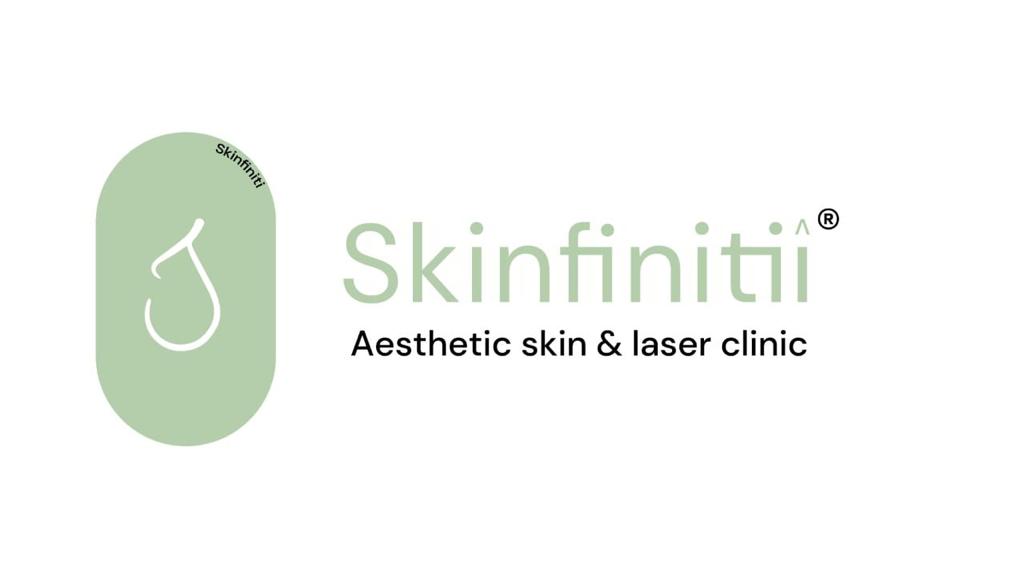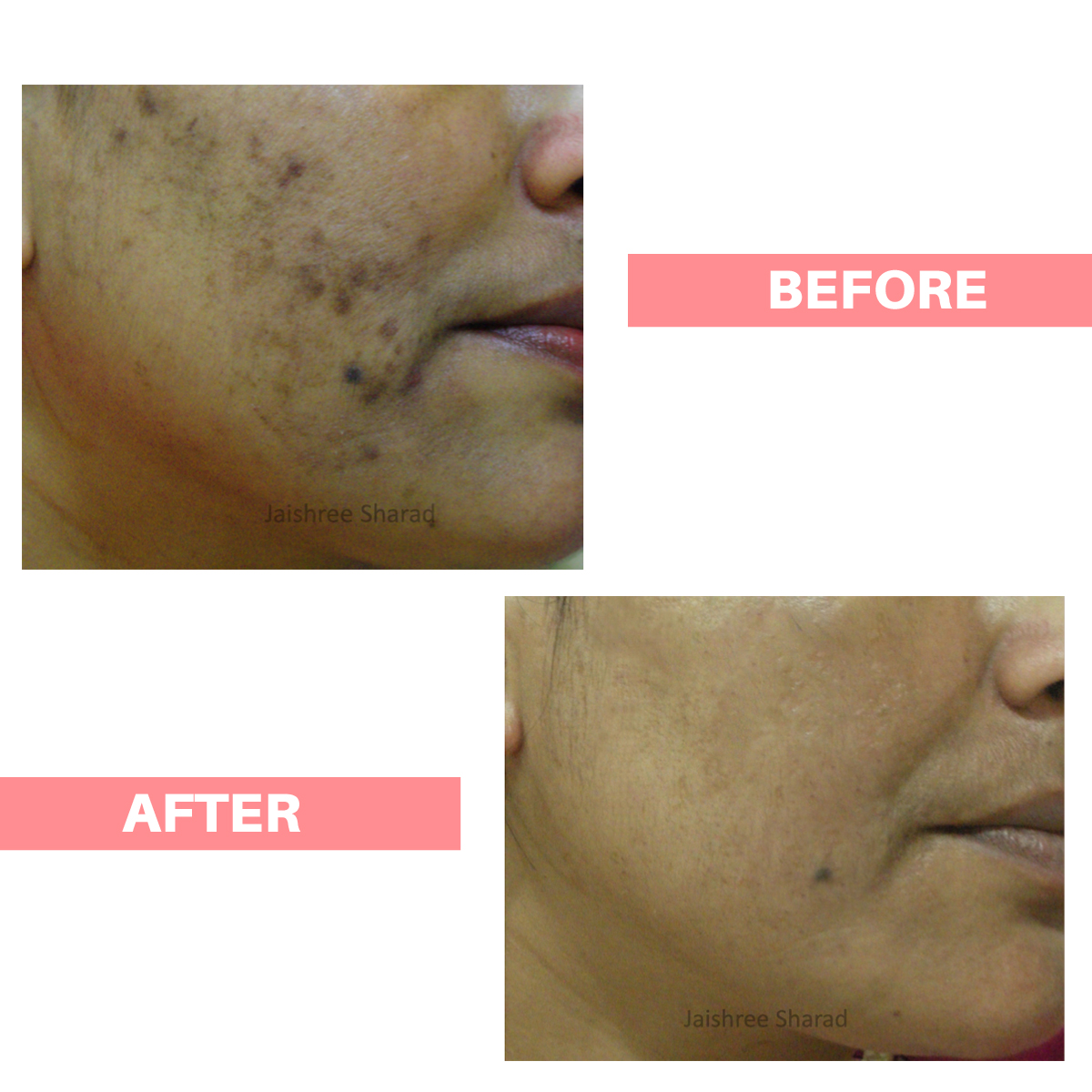Tired of dark patches on the skin? Tired of using concealers all the time ?
Dr Jaishree Sharad will examine your skin and decide on a treatment for your pigmentation depending upon your type of skin and the cause for pigmentation. This includes a step wise approach that includes topical applications, medicines and procedures.
Procedures for pigmentation include Fractional Q switched Nd Yag laser and an array of peels such as Glycolic peels, TCA peel, Yellow peel, Obagi peel, Nomelan peel, Cosmelan peel and many more.
What is the basic structure of the skin and what is responsible for giving it a color ?
Skin is the largest organ of the body. It is made up of two layers, the upper ‘epidermis’ and the lower ‘dermis’. The lowermost layer of the epidermis is known as the basal layer and it contains organelles called ‘melanosomes’. These melanosomes contain cells called melanocytes which produce a pigment called ‘melanin’. The color of skin depends mainly on the amount of melanin. The thickness of epidermis and vascularity of the epidermis are other factors affecting the color of skin.
What are the causes of hyper-pigmentation (increase in skin pigmentation)?
Hyper pigmentation may either be due to increased melanin deposition in the epidermis or dermis. Epidermal pigmentary disorders respond well to treatment while dermal pigmentation may take a long time to lighten.
- Melasma: Seen as brown patches on the face, it is more commonly seen in females. It occurs due to hormonal changes in the body. The pigmentation increases on sun sun exposure.
- Periorbital melanosis: Also known as ‘dark circles’ may be hereditary, due to unhealthy lifestyle, stress, or eye strain
- Freckles and Lentigines: These are tiny dark brown spots on the face and are genetic in origin.
- Photomelanosis: This is increased pigmentation due to sun exposure. The pigmentation occurs on exposed skin, commonly on the face, neck and the back. The pigmentation may be patchy or as diffused darkening of the exposed skin.
- Sunburn (tan): A condition commonly encountered in fair skinned people due to excessive sun exposure.
- Post inflammatory hyperpigmentation: Also known as PIH. It may be seen in the following cases after the healing has occurred, like in acne, eczemas, contact dermatitis, lichen planus, drug induced pigmentation, pigmentation due to cosmetics, etc.
- Macular lichen amyloidosis: It is a genetic condition that typically presents as gray-brown patches that gradually come together and form rippled pattern involving the upper back, arms, chest and thighs.
- Nevus or ‘Birthmark’: Usually seen at birth but may also appear at a later age.
- Tattoo: Tattoos are pigments inserted into the skin for decorative purposes which may at times be a part of tradition. Usually these artificial pigments are inserted deep into the dermis which makes them permanent and stubborn.
What is the treatment for hyper-pigmented disorders?
Melasma, Photomelanosis and post inflammatory hyperpigmentation can be treated with topical creams such as hydroquinone, tretinoin, topical steroids, alpha hydroxy acid creams, azelaic acid, arbutin, liquorice, kojic acid. If the patient does not improve with these medicines other modalities should be used, which may be:
- Chemical peeling: Chemical peeling is application of a solution/gel on the treatment area for a particular time period. It is an office procedure. It does not require any hospitalization. After properly studying the skin type and its sensitivity, the dermatologist decides on the type of peeling agent and their concentration. The skin is first cleansed . The peeling agent is then applied gently onto the lesion or on the full face till the ‘end point’ is achieved. During or shortly after the procedure, the patient might experience warmth or stinging sensation for a few minutes. The procedure can be repeated after 2- 3 weeks.
- Cleopatra used sour milk (lactic acid) & French women used fermented wine (tartaric acid) to look fairer.
- Glycolic acid peel: It is an Alpha hydroxy peel .It is derived from sugarcane extract. It is done to remove blemishes and superficial acne scars and to give an even skin tone.
- Mandelic acid peel: Mandelic acid is an alpha hydroxy peel obtained from bitter almonds. It is a gel peel which is good for sensitive skin. It is done for skin brightening and for active acne.
- Azelaic acid peel: This peel produces an antimicrobial effect, directed onto bacteria Propionibacterium acnes and Staphylococcus epidermidis bacteria. It serves as a natural antioxidant and anti-inflammatory agent. It reduces hyperpigmentation, slows overgrowth of melanocytes which are the pigment forming cells. And hence reduces pigmentation.
- Lactic acid peel: It is an AHA peel obtained from fermented milk. It helps to maintain skin pH. It also moisturizes the skin as is the skin’s own natural moisturizer. It is done in those people who have acne or pigmentation but have sensitive skin.
- Salicylic acid peel: It is a Beta hydroxy peel usually done for acne (whiteheads & blackheads)
- TCA: Trichloroacetic acid peel is excellent for dark spots after acne or after any injuries.
- Arginine peel derived from Brown sugar is used to treat dark circles.
- Kojic Acid peel: Produced by mushrooms of family Aspergillus and Penicillium. It is often used for an instant glow. It reduces blemishes & pigmentation.
- Obagi blue peel: It is a stronger Trichloroacetic acid peel. It should be done with extreme caution by a dermatologist. Done to reduce pigmentation & fine lines.
- Cosmelan peel: Is a whitening peel. To be done by a professional.
- Yellow peel: It is a retinol vitamin A peel done for skin lightening and brightening. It is also used as an anti aging peel since it stimulates collagen thus reduces and prevents fine lines & wrinkles.
- Ormedic peel: Papaya, pineapple, pumpkin, mango and organic extracts of aloe vera based medically effective ingredients designed to rebalance tired, stressed and dull-looking skin. This non-chemical peel naturally rebalances, regenerates, restores and soothes your skin with organic ingredients.
- Black Peel: It is a natural organic peel obtained from black acetic acid, jasmonic acid and salicylic acid. It helps improve various skin problems like active acne, pigmentation and skin aging.
- Mesotherapy: Mesotherapy involves miniscule injections of a skin lightening agent into the skin. It is done with extremely thin needles or with a mesogun. Recently it is done using microneedling. A numbing cream applied to the affected part (dark patches) for 45 mins. The skin is then cleaned and the meso solution applied. This could be vitamin C, trinexamic acid, arbutin, glutathione or kojic acid. The microneedling device is then rolled onto the skin. By doing this, tiny microchannels open up and the solution that is applied before needling penetrates the skin almost 50 times more than a cream would do. The treatment is repeated every 4 weeks for about 8 to 10 sessions till the blemishes and pigmentation subside.
i) Spectra XT LASER: Spectra XT is advanced cutting-edgelaser technology with wavelengths 1064nm and 532nm, for faster and safer skin rejuvenation, to treat pigmentary disorders with new efficient wavelengths that require less downtime.
Spectra is used to treat pigmentation , freckles, melasma, uneven skin tone, tattoo removal, under eye darkness, facial darkening, post-acne redness, facial flushing, enlarged pores, birthmarks and also for skin rejuvenation.
Spectra is a powerful Q-switched Nd:YAG laser with dual pulse mode: Q-switched mode and Spectra mode. Spectra uses laser energy to target pigmentary cells of skin and break down accumulated melanin pigment. It also targets haemoglobin and hence can be used to treat post-acne redness, facial flushing. The beauty of this treatment is that there are no tell tale signs. One can go to work or even for a party immediately after getting the treatment done. ii) 595 nm 2nd Generation “Gold Toning”: Both 585 nm and 595 nm are relatively effective wavelengths, but 595 nm might be slightly safer due to its lower absorption in melanin, thus minimizing potential side effects such as PIH.
Indications :
- Acne
- Removal of minor vascular lesions
- Facial flushing
- Erythema post-treatment with laser
- Post-acne erythema
- Melasma concomitant with abnormal dermal vascular activity
- Café-au-lait macules
- Nevus of Ota, Ito
- ABNOM or Hori’s nevus
- Telangiectasia
- Coagulation
- Traumatic Tattoos
iii) 660nm RuVy Touch: 660 nm is a safer wavelength than 532 nm for removal of epidermal pigmented lesions due to its lower absorption in melanin and oxy- and deoxy-hemoglobin.
In particular, the lower absorption characteristics of 660 nm in ox and deoxy-hemoglobin allow vessels to remain intact even after laser treatment, therefore minimizing potential side effects such as PIH that usually occur as a result of inflammation.
Indications :
- Freckles
- Other epidermal pigmented lesions
- Café-au-lait macules
iv) 1064 nm 45 J “Revital Treatment”: High powered quasi-long pulsed 1064 nm capable of delivering a maximum of 45 J in a second is an effective wavelength to promote good collagen remodeling effect.
Indications :
- Skin rejuvenation
- Seborrhea with enlarged facial pores
- Inflammatory acne lesions with seborrhea
v) ClearLift Laser: Improves fine lines, wrinkles, the appearance of small veins and redness caused by vascularity. It is gentle enough to treat areas that are typically too sensitive to treat with traditional ablative lasers, such as the delicate skin around the eyes, neck, mouth and chest.
ClearLift delivers a controlled dermal wound without harming the overlying epidermis so that all stages of healing and skin repair occur under the intact epidermis. Because ClearLift heats deep beneath the skin (up to 3mm in depth) no numbing is required prior to treatment and all skin healing happens without damaging the outer layer of skin.
It is fast and easy to use. Treatment time is approximately 20 minutes for the full face. It is virtually Painless and there are no tell-tale signs.
One sees a visible improvement in skin appearance in as little as one treatment although best results are seen in 4 to 8 treatment sessions.
Versatile – the 1064 nm Q-Switched module is also indicated for tattoo removal, pigmented and vascular lesions, nail fungus and more. The Q-Switched laser module is indicated for use on all skin types (Fitzpatrick I – VI).


